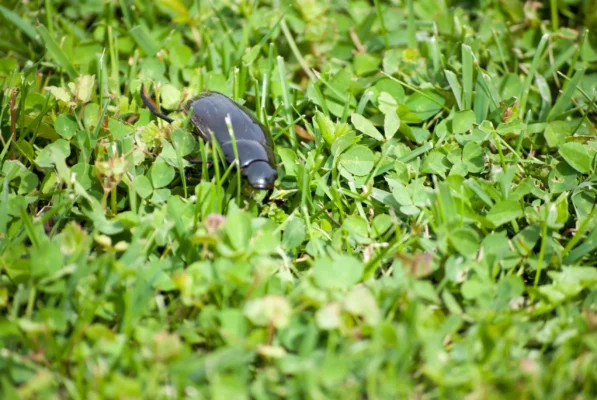In Florida, pests are a recurring concern for both homes and businesses. While a few critters may not pose a threat, an infestation can quickly impact your lawn’s health. Pests can damage grass, cause disease, or create an environment for weeds to thrive. Watch for these signs of trouble:

- Chewed or Notched Grass Blades: Inspect your grass regularly for damage like chewed or notched edges, yellow or brown patches, or irregular thinning and dying areas. Pests like insects or grubs often cause this type of harm by feeding on the grass.
- Changes to Your Lawn’s Health: Notice any changes in your lawn’s growth, such as wilting, uneven growth, or stress without a clear cause. These can be indicators of a pest infestation affecting the grass.
- Sudden Outbreak of Weeds: An increase in weed growth or the appearance of persistent new weeds can signal an underlying pest issue, as pests often contribute to an environment that encourages weeds.
- Pest Activity: Look for visible pests or signs of their activity, like insects, larvae, or adults moving on the grass or hiding in the thatch or soil. Other indicators include tunnels, webbing, or mounds, which suggest burrowing pests.
- Animal Digging or Droppings: Animals like raccoons, skunks, or armadillos may dig in search of insects or grubs, leaving behind signs of digging, disturbed soil, or animal droppings, indicating pest activity beneath the surface.
Need Lawn Care? We Can Help.
Click the button below to leave your information & we'll be in touch in an hour or less.
Need Pest Control Service?
Leave your information below and we’ll be in touch with a FREE quote!
"*" indicates required fields
*During normal business hours. After hours calls will be returned the next business day.
What to Do If You Have Pests in Your Lawn
Finding pests in your yard means it’s time to take action quickly. Outdoor infestations are especially challenging due to uncontrollable environmental factors that boost pest numbers. Try these effective tips to tackle lawn pests:
- Identify the Pest Species: Understanding the specific pest causing trouble is key to managing the problem effectively. Different species behave differently, so knowing the type of pest allows you to tailor your treatment plan accordingly.
- Trim the Grass and Reduce Debris: Pests thrive in environments with ample hiding spots. Keeping your grass between 2 ½ and 3 inches long and removing fallen leaves and twigs can make your lawn less inviting to unwanted pests.
- Control Excess Moisture: Insects and rodents are often attracted to damp conditions. Overwatered lawns are particularly vulnerable to infestations. If you notice squishy grass or signs of fungal growth, adjust your watering schedule to keep your lawn dry.
- Consult a Professional: Sometimes, despite your best efforts, managing a pest infestation can be overwhelming. If you’re still dealing with pests after trying these methods, contacting a lawn care expert can help eliminate the problem quickly and ensure long-term protection. They have the tools and expertise to protect your lawn effectively.
